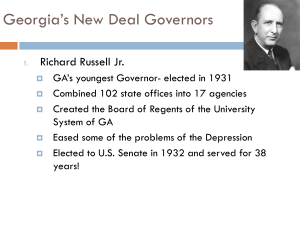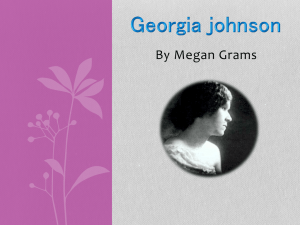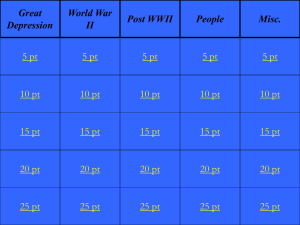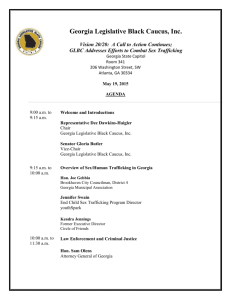File - Mrs. Deck`s Social Studies
advertisement
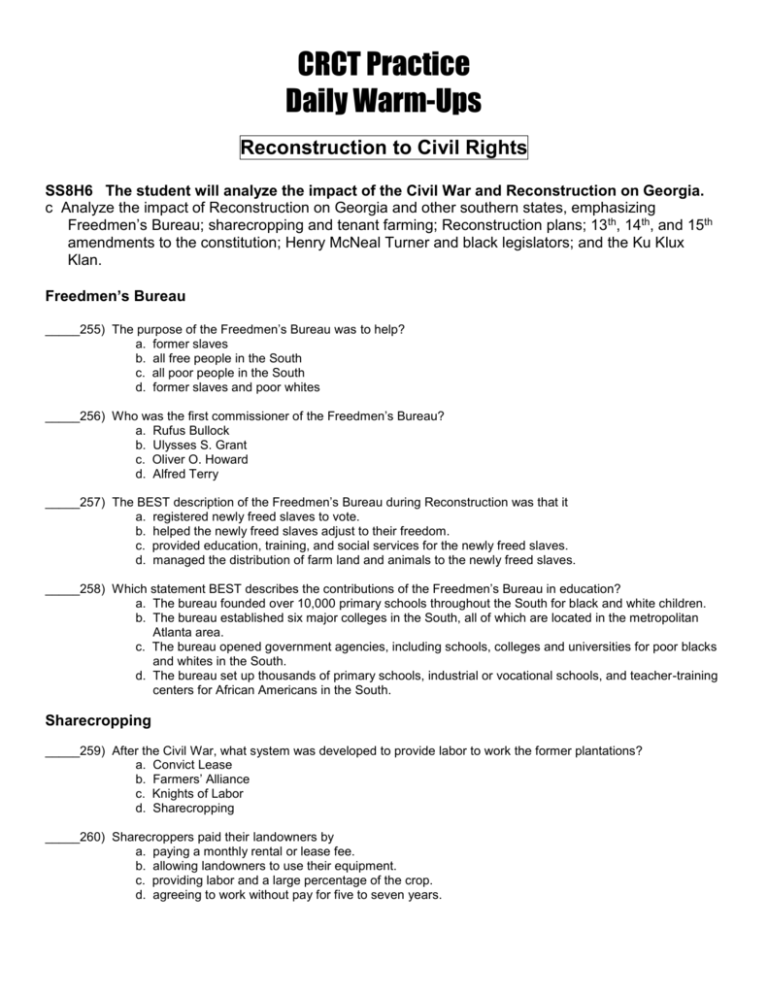
CRCT Practice Daily Warm-Ups Reconstruction to Civil Rights SS8H6 The student will analyze the impact of the Civil War and Reconstruction on Georgia. c Analyze the impact of Reconstruction on Georgia and other southern states, emphasizing Freedmen’s Bureau; sharecropping and tenant farming; Reconstruction plans; 13th, 14th, and 15th amendments to the constitution; Henry McNeal Turner and black legislators; and the Ku Klux Klan. Freedmen’s Bureau _____255) The purpose of the Freedmen’s Bureau was to help? a. former slaves b. all free people in the South c. all poor people in the South d. former slaves and poor whites _____256) Who was the first commissioner of the Freedmen’s Bureau? a. Rufus Bullock b. Ulysses S. Grant c. Oliver O. Howard d. Alfred Terry _____257) The BEST description of the Freedmen’s Bureau during Reconstruction was that it a. registered newly freed slaves to vote. b. helped the newly freed slaves adjust to their freedom. c. provided education, training, and social services for the newly freed slaves. d. managed the distribution of farm land and animals to the newly freed slaves. _____258) Which statement BEST describes the contributions of the Freedmen’s Bureau in education? a. The bureau founded over 10,000 primary schools throughout the South for black and white children. b. The bureau established six major colleges in the South, all of which are located in the metropolitan Atlanta area. c. The bureau opened government agencies, including schools, colleges and universities for poor blacks and whites in the South. d. The bureau set up thousands of primary schools, industrial or vocational schools, and teacher-training centers for African Americans in the South. Sharecropping _____259) After the Civil War, what system was developed to provide labor to work the former plantations? a. Convict Lease b. Farmers’ Alliance c. Knights of Labor d. Sharecropping _____260) Sharecroppers paid their landowners by a. paying a monthly rental or lease fee. b. allowing landowners to use their equipment. c. providing labor and a large percentage of the crop. d. agreeing to work without pay for five to seven years. _____261) With whom did sharecroppers share their harvest? a. landowners b. neighbors c. creditors d. the poor Tenant Farming _____262) How were tenant farmers different from sharecroppers? a. Tenant farmers owned all their equipment. b. Tenant farmers usually made a small profit. c. Tenant farmers bought their seed from the owner. d. Tenant farmers usually didn’t pay rent for their houses. _____263) Which best describes the differences between sharecropping and tenant farming? a. Sharecroppers received a percentage of the crops produced and could set aside case money to purchase their own land, while tenant farmers had difficulty saving cash. b. Sharecroppers owned nothing but their labor, while tenant farmers owned farm animals and equipment to use in working other people’s lands. c. Tenant farmers received a cash salary or wage for their farm work, while sharecroppers received only a portion of the crops they raised. d. Tenant farmers earned equity or an interest in the land they worked from year to year so that eventually they would own their own property. Reconstruction Plans _____264) What was President Abraham Lincoln’s plan for Reconstruction called? a. 10 Percent Plan b. 100 Percent Plan c. Congressional Plan d. Radical Republican Plan _____265) To whom did President Johnson’s Reconstruction Plan deny a general pardon? a. Southerners who owned more than 25 slaves. b. Southerners who owned more than 50 slaves. c. Southerners who owned more than $20,000 worth of land. d. Southerners who owned more than $50,000 worth of land. _____266) Why was President Lincoln’s Reconstruction Plan not enacted? a. The Wade-Davis bill took its place. b. The plan was too easy on the South. c. The plan did not have the support of the states. d. The plan did not become effective before Lincoln was assassinated. _____267) Why did President Johnson appoint James Johnson as provisional governor of Georgia in 1865? a. He had opposed succession as a congressman. b. He was extremely popular with the people of Georgia. c. He denounced the Congressional Reconstruction Plan. d. He had supported Johnson when he ran for vice president. _____268) Which statement best describes the most important difference between the Reconstruction plans of President Lincoln and the radical Congress? a. Lincoln’s plan involved bringing the nation back together to heal the wounds of war. b. The Congressional plan sought to punish the South and prevent its reentry into the Union. c. Lincoln’s plan required loyalty oaths and sought to help the South reenter the Union quickly. d. The Congressional plan treated the southern states like conquered provinces requiring Congress to monitor the treatment of freedmen. 13th, 14th, and 15th Amendment _____269) What did the 13th Amendment to the US Constitution do that brought about many changes in Georgia’s society and economic structure after the Civil War? a. It freed the slaves. b. It changed who owned land. c. It gave blacks the right to vote. d. It made blacks United States citizens. _____270) Under the terms of the radical Congressional plan of Reconstruction, what amendment did a southern state have to ratify before it could rejoin the Union? a. 13th b. 14th c. 15th d. 16th _____271) What did the 14th Amendment to the US Constitution do? a. It abolished slavery. b. It gave blacks citizenship. c. It gave blacks the right to vote. d. It gave blacks the right to own property. _____272) What did the 15th Amendment to the US Constitution do? a. It abolished slavery. b. It gave blacks citizenship. c. It gave blacks the right to vote. d. It gave blacks the right to own property. _____273) The 14th Amendment to the US Constitution was passed in response to the a. Adoption of laws known as Black Codes by the southern states. b. Rising violence from terrorist organizations such as the Ku Klux Klan. c. Refusal of white southerners to provide freedmen with land and farm animals. d. Refusal of some southern states to adopt constitutional provisions calling for an end to slavery. Henry McNeal Turner and Black Legislators _____274) Henry McNeal Turner was expelled from his seat in the Georgia state legislature on the grounds that he did not a. win the election fairly and honestly. b. have the knowledge to be a legislator. c. have the right to vote or hold political office. d. live in the district from which he was elected. _____275) Which political organization did African Americans join during Reconstruction? a. the Union League b. the Ku Klux Klan c. the Freedmen’s Bureau d. the Civil Rights Bureau Ku Klux Klan _____276) Beginning soon after the end of the Civil War, what secret organization used force and violence to influence Georgia’s society? a. United Confederate Veterans b. Free and Accepted Masons c. Freedmen’s Bureau d. Ku Klux Klan _____277) The Ku Klux Klan began in Tennessee in 1865 as a a. Social club. b. Terrorist group. c. College fraternity. d. Church organization. _____278) Perhaps the main goal of the Ku Klux Klan was to a. Return control of the southern governments to the Democrats. b. Force the carpetbaggers to move back north. c. Attract members from all social classes. d. Return land to former Confederates. _____279) What was the Georgia Act of 1869? a. Federal legislation returning Georgia to military control of KKK terrorism against freedmen b. Federal legislation refusing to admit Georgia to the Union until it ratified the 13 th Amendment c. State legislation allowing freedmen the right to vote and the right to hold public office d. State legislation ending Reconstruction in Georgia thanks to its demonstrated success SS8H7 The student will evaluate key political, social and economic changes that occurred in Georgia between 1877 and 1918. a. Evaluate the impact the Bourbon Triumvirate, Henry Grady, International Cotton States Exposition, Tom Watson and the Populists, Rebecca Latimer Felton, the 1906 Atlanta Riot, the Leo Frank Case, and the county unit system had on Georgia during this period. 1906 Atlanta Riot _____298) The immediate cause of the riot that occurred in Atlanta in 1906 was a. the killing of a black family. b. blacks being denied the right to vote. c. the election of Hoke Smith as governor. d. stories of black violence against whites in the Atlanta newspapers. _____299) How long did the Atlanta riot of 1906 last? a. 12 hours b. 18 hours c. 24 hours d. 48 hours _____300) Which was one result of the Atlanta riot of 1906? e. five blacks were executed f. downtown Atlanta was set on fire g. at least 18 blacks were killed h. the president sent in the national guard Leo Frank Case _____301) The murder trial of Leo Frank resulted in a e. mistrial. f. acquittal. g. hung jury. h. death sentence. _____302) The racial unrest brought about by the Leo Frank case resulted in the creation of a chapter of the Ku Klux Klan, which called itself the Knights of a. Columbus. b. Leo Frank. c. Mary Phagan. d. Stone Mountain. _____303) What happened to Leo Frank after his trial? a. He was sentenced and put to death. b. He was taken from jail and lynched. c. He spent the rest of his life in prison. d. He was found guilty, but was later freed. County Unit System _____304) The county unit system affected voting and politics in Georgia by a. favoring cities where most people lived. b. focusing power inside the Atlanta area. c. helping blacks get more voting power. d. giving the rural areas more power. _____305) Who benefited from the county unit system? a. cities b. rural areas c. metro regions d. heavily populated counties _____306) What was a positive aspect of the county unit system? a. It was easy to buy votes. b. It was difficult to administer. c. It allowed people to be elected without a majority of the popular vote. d. It allowed less populated areas to have the same political power as larger populated areas. _____307) Which piece of legislation allowed less populated counties in Georgia to have the same or greater power and influence in the General Assembly as the more populated counties? a. Worchester v. Georgia b. Neill Primary Act c. Populist Party d. Watson’s RFD SS8H7 The student will evaluate key political, social, and economic changes that occurred in Georgia between 1877 and 1918. b. Analyze how rights were denied to African-Americans through Jim Crow laws, Plessy v. Ferguson, disenfranchisement, and racial violence. Jim Crow Laws _____308) What was the purpose of the “Jim Crow” or segregation laws passed by Georgia’s government at the turn of the century? e. To make alcohol illegal f. To continue white control g. To promote industry in Georgia h. To provide equality for black Georgians _____309) Who called Georgia’s civil rights laws “barbarous”? e. Henry McNeal Turner f. Martin Luther King, Jr. g. Leo Frank h. Rebecca Latimer Felton Plessy v. Ferguson _____310) What became legal under Plessy v. Ferguson? e. Blacks and whites could have separate schools. f. Blacks and whites could attend the same schools. g. Blacks and whites could be admitted to the same hospital. h. Blacks and whites could drink from the same water fountain. _____311) Plessy v. Ferguson gave states the right to promote e. Equal rights. f. Segregation. g. Terrorist attacks. h. Voting rights for blacks. _____312) According to Plessy v. Ferguson, what Constitutional amendment was NOT violated by establishing “separate-but-equal” facilities? a. 13th Amendment b. 14th Amendment c. 15th Amendment d. 16th Amendment _____313) Homer Plessy sat in the “Whites Only” car on a train because he wanted a. the only seat available. b. the comfortable seats there. c. to sit with his traveling companions. d. to test the legality of a law requiring separate-but-equal facilities. _____314) What Georgia case tested the decision in Plessy v. Ferguson? a. Roe v. Wade b. Worcester v. Georgia c. Brown v. Board of Education d. Cummings v. Richmond County Board of Education Disenfranchisement _____315) The purpose of the Grandfather clause of 1908 was to a. Take the right to vote away from blacks. b. Make everyone trace their family background. c. Give grandfathers opportunities to get better jobs. d. Ask every family to guarantee living quarters for the elderly. _____316) Why did Georgia’s political leaders adopt such policies as the grandfather clause and white primary during the early 1900s? a. To create the county unit system b. To segregate Georgia’s schools c. To stop blacks from voting d. To allow women to vote _____317) Which voting qualification was designed to prevent African Americans from voting? a. Literacy test b. Party affiliation c. Identification number d. Residency requirement _____318) In 1920, the 19th Amendment to the US Constitution was ratified. How did this amendment change the makeup of those who could vote in Georgia? a. It allowed blacks to vote. b. It allowed women to vote. c. It stopped blacks from voting. d. It stopped women from voting. SS8H7 The student will evaluate key political, social, and economic changes that occurred in Georgia between 1877 and 1918. c. Explain the roles of Booker T. Washington, W. E. B. DuBois, John and Lugenia Burns Hope, and Alonzo Herndon. Booker T. Washington _____319) Where is Tuskegee Institute, founded by Booker T. Washington, located? a. Alabama b. Arkansas c. Georgia d. Mississippi _____320) What belief would Booker T. Washington NOT support? a. Vocational education was essential for African Americans who sought equality. b. Truth and knowledge would cause different races to understand and accept each other. c. Economic equality was much more important than social equality for African Americans. d. Political and social equality for African Americans would come from economic independence. _____321) What racial issue did Booker T. Washington support? a. Economic equality b. Political equality c. Religious equality d. Social equality W. E. B. Dubois _____322) What racial issue, opposed by Booker T. Washington, did W. E. B. DuBois support? a. Economic equality b. Political equality c. Religious equality d. Social equality _____323) Which African American leader believed that a “Talented Tenth” of the African American population could serve as leaders for all other African Americans? a. Frederick Douglas b. W. E. B. DuBois c. John Hope d. Booker T. Washington John and Lugenia Burns Hope _____324) Who was the first black president of Atlanta Baptist College? a. Frederick Douglas b. W. E. B. DuBois c. John Hope d. Booker T. Washington _____325) To what did Atlanta Baptist College change its name? a. Atlanta University b. Morehouse c. Morris Brown d. Spelman _____326) What organization was founded by Lugenia Burns Hope? a. D.E.C.C.A. b. Girl Scouts c. Neighborhood Union d. Y.W.C.A. _____327) All of the following services were offered by the organization founded by Lugenia Burns Hope EXCEPT a. Remedial education classes. b. Financial aid for the needy. c. Clubs for boys and girls. d. Vocational classes. Alonzo Herndon _____328) What business made Alonzo Herndon a successful businessman? a. Atlanta Mutual Insurance Company b. Coca-Cola c. Georgia Pacific d. Western and Atlantic Railroad _____329) Alonzo Herndon became a successful businessman by a. Hiring college graduate to run his company. b. Becoming the sole employee of his new business. c. Moving his company to a larger metropolitan area. d. Spending hundreds of thousands of dollars on advertising. SS8H11 The student will evaluate the role of Georgia in the modern civil rights movement. a. Describe major developments in civil rights and Georgia’s role during the 1940s and 1950s include the roles of Herman Talmadge, Benjamin Mays, the 1946 governor’s race and the end of the white primary. Brown v. Board of Education, Martin Luther King, Jr., and the 1956 state flag. Benjamin Mays _____406) What office did Benjamin Mays hold? a. State legislator b. Mayor of Atlanta c. Governor of Georgia d. Atlanta Board of Education member _____407) Benjamin Mays served as a mentor to a. Maynard Jackson b. Martin Luther King, Jr. c. Rosa Parks d. Andrew Young End of the White Primary _____408) The purpose of the white primary was to a. Help blacks get elected to statewide public office. b. Keep blacks from having input into the party nominees. c. Allow blacks to have more influence in the general election. d. Promote voting by blacks in the early stages of the electoral process. _____409) Under the white primary system, only whites were allowed a. To vote in primary elections. b. To vote in statewide elections. c. To belong to the Democratic party. d. To run for political office in Georgia. 1946 Governor’s Race _____410) The famous controversy surrounding the 1946 election for governor came about because a. Two men got the same number of votes for governor. b. Herman Talmadge and Eugene Talmadge were on the same ballot. c. Eugene Talmadge died before taking office, and two men claimed the office. d. Carmichael got more popular votes, and Talmadge got more county unit votes. _____411) When Eugene Talmadge died in 1946 before taking office for his 4 th term as governor, who became governor? a. The previous governor remained governor. b. Three people claimed to be Georgia’s governor. c. Georgia’s lieutenant governor became governor. d. The speaker of the General Assembly became governor. _____412) In the 1946 Democratic primary for governor, who received the largest popular vote? a. James Carmichael b. Lester Maddox c. Ed Rivers d. Herman Talmadge Herman Talmadge _____413) What factor enabled Herman Talmadge to be elected governor of Georgia in 1950? a. His victory in the 1948 special election for governor. b. His position on segregation and voting rights. c. His support from wealthy businessmen. d. His campaign style and popularity. _____414) In what area did Herman Talmadge make his greatest contributions as governor? a. Attracting new business b. Voting rights c. Tax reform d. Education _____415) Herman Talmadge’s 3 percent sales tax was passed primarily to fund a. A lengthened school year and school improvements. b. Georgia’s part in the Interstate Highway System. c. The purchase of Jekyll Island as a state park. d. The creation of county health departments. Brown v. Board of Education _____416) What was the ruling of the US Supreme Court in Brown v. Board of Education? a. Schools would be segregated and kept separate. b. The separate-but-equal policy was unconstitutional. c. Black schools would get more money for books and teachers. d. Blacks could only attend white schools if there was space available. _____417) What earlier US Supreme Court decision did the ruling in Brown v. Board of Education overturn? a. Cummings vs. Richmond County Board of Education b. The Dred Scott Decision c. Plessy v. Ferguson d. Worchester v. Georgia Martin Luther King, Jr. _____418) Dr. Martin Luther King, Jr., favored bringing about social change through a. Unity. b. Democracy. c. Compromise. d. Nonviolence. _____419) Which approach did Dr. Martin Luther King, Jr., NOT use to gain equality and civil rights for all citizens? a. Economic boycotts of businesses that did not treat all citizens fairly. b. Direct and nonviolent actions such as marches, protests, and demonstrations. c. Aggressive pursuit of black power through protests, riots, demonstrations, and political organization. d. Legal actions against individuals and businesses that violated the civil rights of individuals based on race. 1956 State Flag _____420) Which group was instrumental in getting the 1956 Georgia state flag changed? a. Atlanta Convention and Visitors Bureau b. Supporters of Governor Zell Miller c. Public school students d. Rainbow Coalition _____421) In what year did the Georgia state flag become an issue in the race for governor? a. 1960 b. 1968 c. 1984 d. 2000 _____422) What was one reason for keeping the Georgia state flag of 1956? a. It was easy for school children to draw. b. It was a memorial to the Confederate dead. c. It was supported by a majority of Georgians. d. It was similar to the flags of other southern states. SS8H11 The student will evaluate the role of Georgia in the modern civil rights movement. b. Analyze the role Georgia and prominent Georgians played in the Civil Rights Movement of the 1960s and 1970s; include such events as the founding of the Student Non-Violent Coordinating Committee (SNCC), Sibley Commission, admission of Hamilton Holmes and Charlayne Hunter to the University of Georgia, Albany Movement, March on Washington, Civil Rights Act, the election of Maynard Jackson as mayor of Atlanta, and the role of Lester Maddox. Student Non-Violent Coordinating Committee _____423) What organization was founded two months after the 1960 sit-in at the Woolworth’s lunch counter in Greensboro, North Carolina? a. CORE b. NAACP c. SCLC d. SNCC _____424) Who was the first president of the Student Non-Violent Coordinating Committee? a. H. Rap Brown b. Maynard Jackson c. Dr. Martin Luther King, Jr. d. John Lewis _____425) Which statement does NOT illustrate Georgia’s initial reaction to the Brown v. Board of Education decision of the US Supreme Court? a. The governor pledged not to integrate the state’s schools. b. Georgia citizens voted 3 to 2 to close schools rather than integrate them. c. The General Assembly voted to cut off state funds to any schools that desegregated. d. The Sibley Commission traveled throughout the state encouraging the peaceful desegregation of schools. _____426) The purpose of the Sibley Commission was to a. Study the problem of school integration. b. Develop a plan for securing jobs for blacks. c. Set up a series of meetings to bring blacks and whites together. d. Make recommendations for desegregation in public transportation. _____427) The Sibley Commission recommended a. Integrating Georgia’s public transportation system. b. Making proposals to the legislature to address racial issues. c. Establishing a quota system to ensure the hiring of black workers. d. Allowing local school systems to decide if they wanted integration. Hamilton Holmes/Charlayne Hunter _____428) Who was one of the first blacks to be admitted to the University of Georgia? a. Charlayne Hunter b. Maynard Jackson c. Rosa Parks d. Andrew Young _____429) Who was the governor of Georgia when the first black students were admitted to the University of Georgia? a. Lester Maddox b. Ed Rivers c. Herman Talmadge d. Ernest Vandiver Albany Movement _____430) The focus of the Albany Movement in Georgia was to a. End segregation of public schools in Albany. b. Integrate interstate bus station waiting rooms in Albany. c. Implement a “first-come, first-served” policy on Albany buses. d. Force the hiring of African American bus drivers for Albany’s bus station. _____431) Which African American group was involved with the Albany Movement? a. CORE b. Interstate Commerce Commission c. Montgomery Improvement Association d. SNCC March on Washington 1963 _____432) Dr. Martin Luther King, Jr.’s “I have a Dream” speech is associated with the a. Montgomery bus boycott. b. March on Washington, D.C. c. “Letter from the Birmingham Jail” d. Eulogy given at the funeral of Martin Luther King, Sr. _____433) The march on Washington was intended to a. Urge the passage of a civil rights bill. b. Extend the Montgomery bus boycott. c. Integrate the Washington, D.C. public schools. d. Honor the memory of slain civil rights workers. Civil Rights Act _____434) The Civil Rights Act of 1964 did NOT integrate a. Public recreational areas. b. Restaurants. c. Churches. d. Hotels. _____435) What did the Civil Rights Act of 1964 do? a. It named black principals at previously all-white schools. b. It gave more state tax money to schools that did not integrate. c. It withheld federal funds from schools that did not end segregation. d. It provided armed escorts for students wanting to attend white schools. _____436) Which method of influencing political decision making led to the Civil Rights Act of 1964? a. The ballot b. Freedom fighters c. Special interest groups d. The power of public opinion Maynard Jackson _____437) Who was the first African American mayor of Atlanta? a. Hamilton Holmes b. Maynard Jackson c. Sam Massell d. Andrew Young Use these actions to answer question 438: ●He increased programs for the arts. ●He addressed the need to expand the airport. ●He led an effort to have the Olympics held in Atlanta. _____438) Which mayor of Atlanta promoted these improvements for the city? a. Ivan Allen b. Maynard Jackson c. Sam Massell d. Andrew Young Lester Maddox _____439) What did Lester Maddox accomplish as governor? a. Started the lottery and HOPE scholarships b. Decreased funding to public schools and the arts c. Changed the state flag to remove the Confederate symbols d. Appointed more African Americans to state boards than all prior governors combined _____440) How did Lester Maddox get input from the voters? a. Monthly luncheons b. People’s Days c. Statewide caravans d. Suggestion boxes _____441) Which governor won office by being elected by the General Assembly rather than the people? a. Ellis Arnall b. Roy Barnes c. Lester Maddox d. Zell Miller SS8H11 The student will evaluate the role of Georgia in the modern civil rights movement. c. Discuss the impact of Andrew Young on Georgia. Andrew Young _____442) Andrew Young helped establish “citizenship schools,” which taught a. Young blacks their rights of citizenship. b. Nonviolent organizing strategies to potential leaders. c. The art of campaigning to potential black political leaders. d. The basic principles found in the US Constitution to high school students. _____443) What event was the MOST significant in Andrew Young’s political career? a. He was involved in the stock market after he left the ministry. b. He was the youngest African American governor to be elected in Georgia. c. He was the first African American to graduate from the University of Georgia. d. He was the first African American since Reconstruction to be elected to the House of Representatives from Georgia. _____444) Which position has NOT been held by Andrew Young? a. Governor of Georgia b. US congressman c. Mayor of Atlanta d. College Professor Miscellaneous ____1) What was the purpose of the Freedmen’s Bureau? a. To fight for the freedom of Southern slaves b. To oppose federal troops in Reconstruction Georgia c. To make sure former slaves did not exercise their rights d. To provide former slaves with basic needs _____2) What is the relationship between Brown v. Board of Education and Plessy v. Ferguson? a. Plessy v. Ferguson overturned the decision in Brown v. Board of Education to allow Jim Crow laws to remain in Georgia. b. Plessy v. Ferguson approved the idea of “separate but equal” and Brown v. Board overturned it. c. The only thing the cases have in common is that they both dealt with race relations. d. Brown v. Board was the case that supported the decision made in Plessy v. Ferguson to allow “separate but equal” facilities. _____3) The work of the Sibley Commission related to the social problem of a. Poverty. b. Droughts. c. Segregation. d. Immigration. _____4) Since the civil rights movement, how has Andrew Young continued to have an impact on Georgia? a. His uncompromising personality and angry protests have led to many conflicts between Georgia and the rest of the world. b. As a UN Ambassador and member of the Olympic committee, he has brought much positive international attention to Georgia. c. Being the first US President from Georgia, many foreign leaders have visited the state since his term in office. d. Because of his work, Georgia does not have to deal with issues of race or inequalities anymore.

